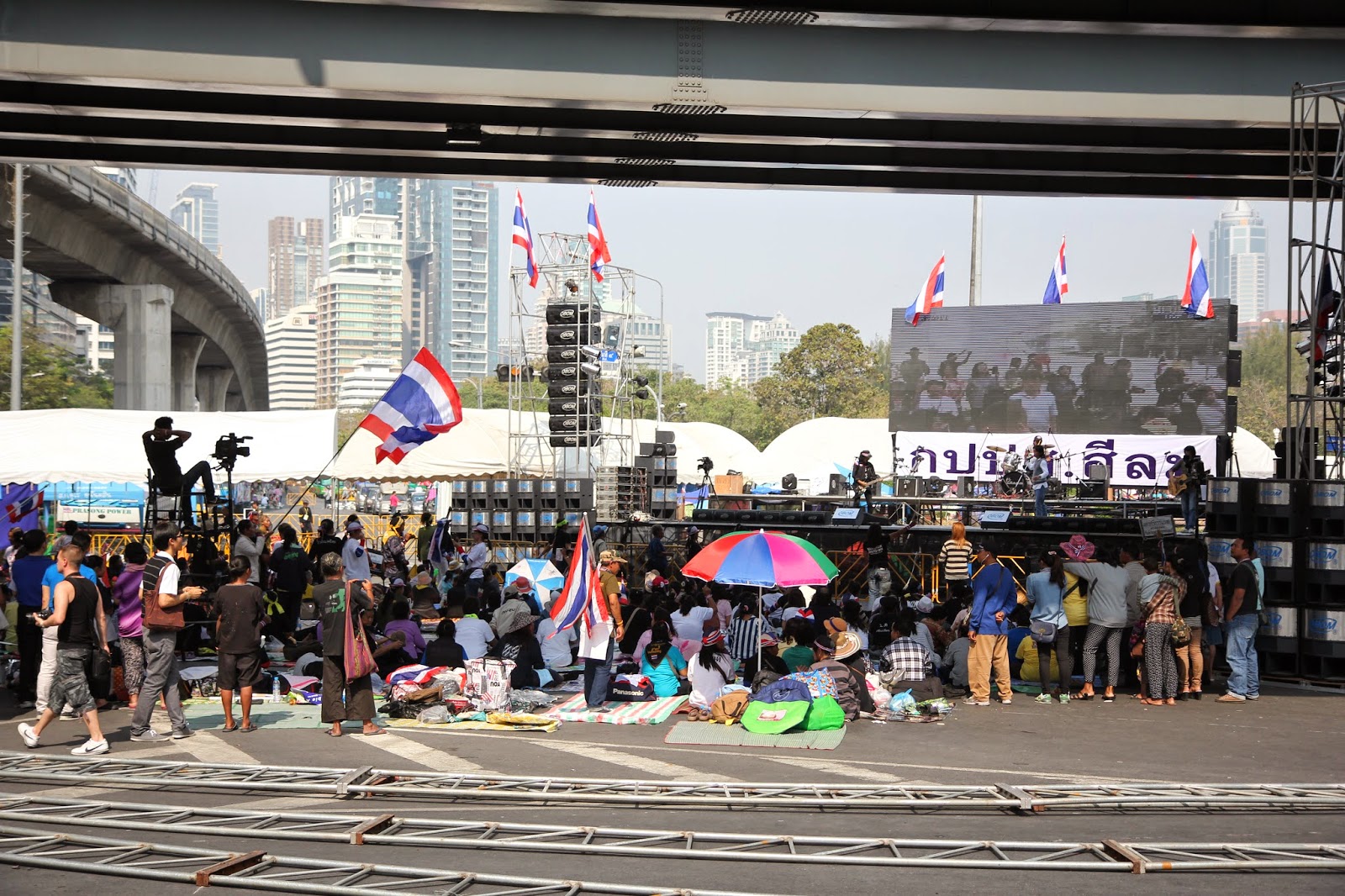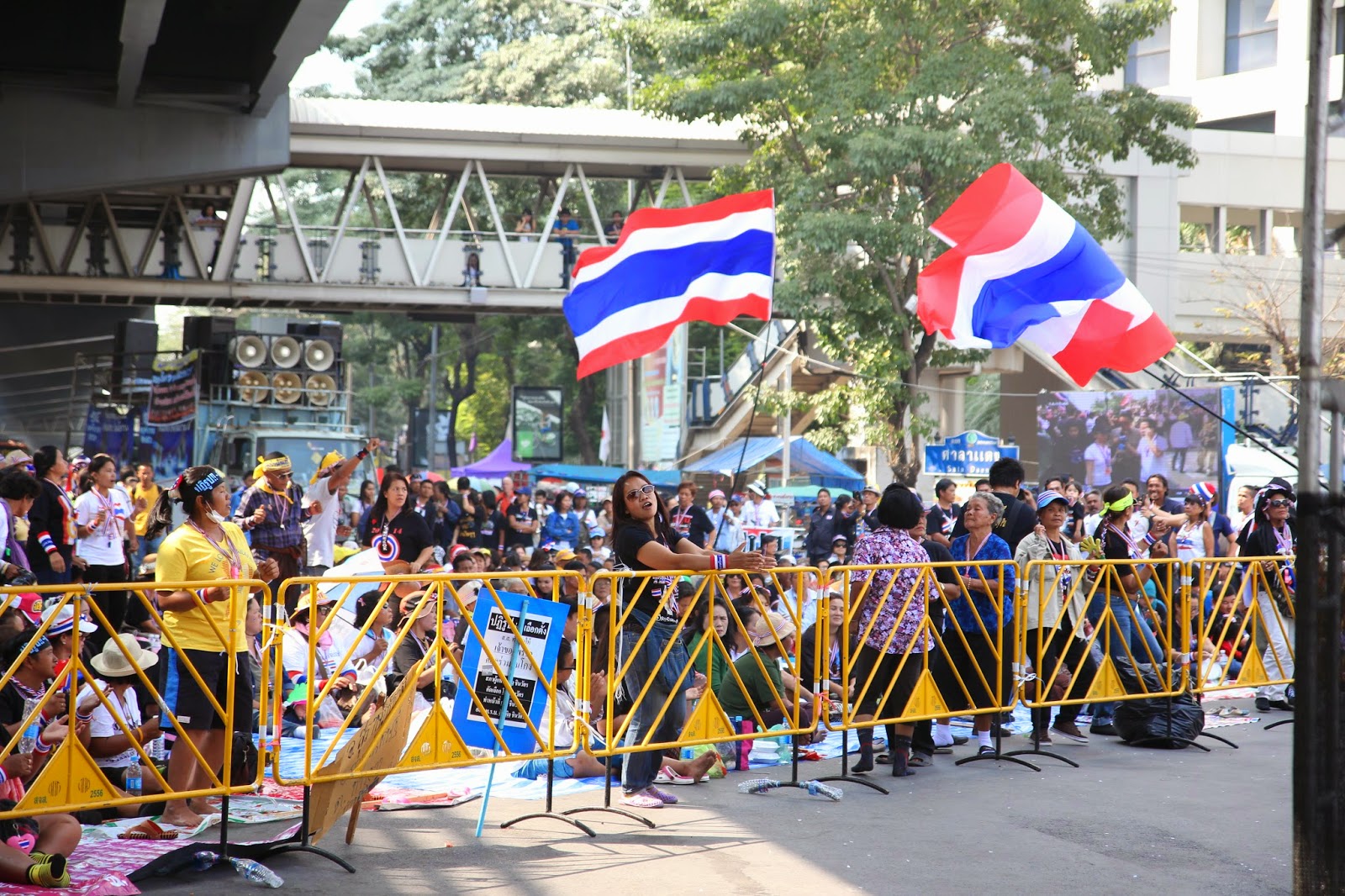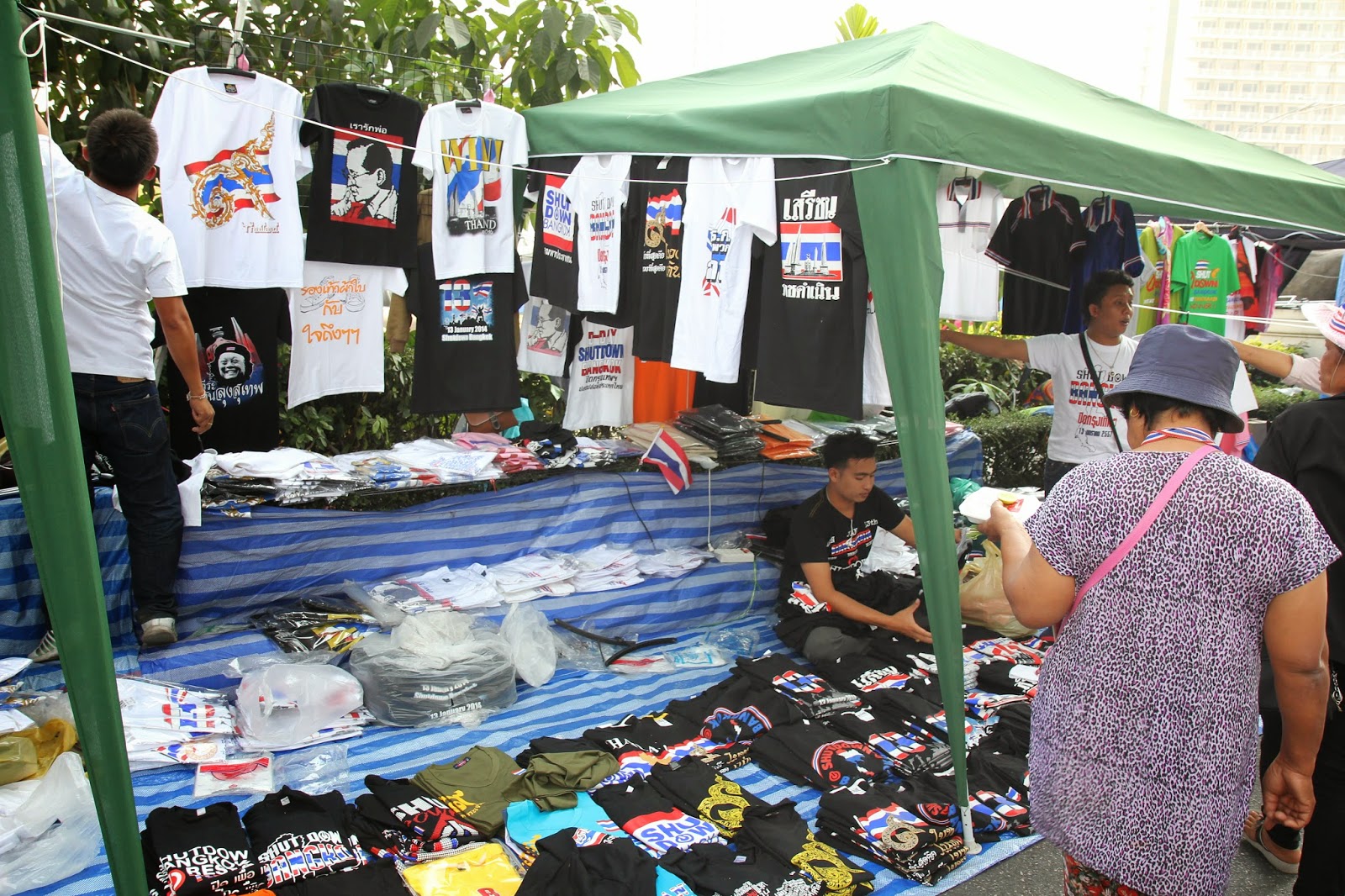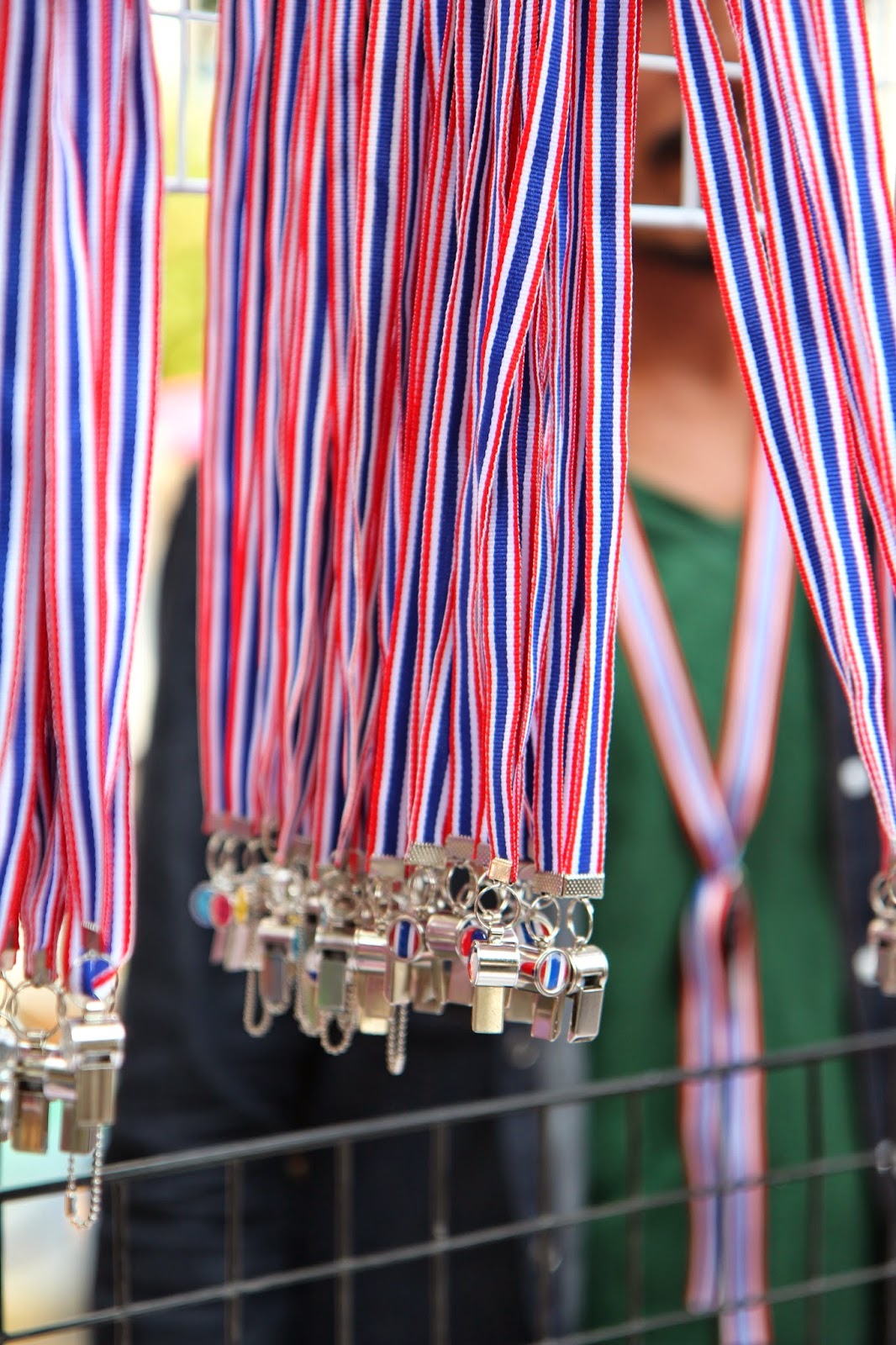The political unrest in Thailand has been surfacing in news reports quite a bit in the past month or so. I subscribe to TIME's newsfeed, and a few stories about the increasing tension in Bangkok came up in the days before I was to arrive there. I also followed the website and live updates of
Richard Barrow, which were helpful. While the news stories painted a grim picture, the reality is that the ongoing demonstrations are
not making Bangkok unsafe for tourists and travelers, as long as they are smart about where they go in the city and when.
What's happening over there, anyway? I wasn't well-read on the issue itself going in, but part of the reason I travel is to learn things. The more people I met and talked to in Thailand, the more I could piece together a lot of what was going on, and since returning home I've been following the news closely.
 |
| Bangkok Shutdown protest site near Sala Daeng Station. |
Bangkok has been "
shut down" by protestors since mid-January. Tens of thousands of citizens are camping indefinitely in various parks and near primary government buildings. A few major roads have been closed down, causing citywide traffic disruptions, but public transportation such as the Skytrain and airports and large tourist attractions are unaffected.
The protestors want current Prime Minister Shinawatra to step down from office. They believe she is guilty of corruption and illegal collaboration with an exiled former PM -- who happens to be her older brother. The siblings' political influence has stood strong for a decade; their party routinely sweeps all the votes of Thailand's farmers and poorer rural citizens in the populous north and northeast. A policy in which the government buys farmers' subsidized rice surely counts in the current ruling party's favor. On the other hand, southerners, city-dwellers, and the middle class oppose them and are literally demanding that the entire government be replaced.
 |
| Thaksin is the guilty and exiled ex-PM. His sister, Yingluck Shinawatra, is the current PM trying to hold on to her seat. |
In response to the protests, Shinawatra dissolved Thailand's parliament and scheduled new elections for February 2nd. (Everywhere I traveled in Thailand, I saw large glossy campaign posters.) However, the protestors won't settle for elections, since they distrust the voting system itself. Instead, they want a purely democratic "people's council" to take over governmental affairs: "Reform before election" is one of their rallying cries.
Although the current shutdown has culminated from protests that began last November, in reality, the political unrest has surfaced continuously in the past decade; protests and demonstrates erupt every few years and have been violent and even fatal. Here is a very thorough
analysis of the big picture from CNN that ends with a "bleak prognosis" for Thailand.
 |
| A protestor beneath the Thai flag. (He totally knew I was taking a photo of him.) |
Day 2 (Jan. 25): Bangkok Protests
So what was my experience, exactly? Recall that on the day I met my father's friend for lunch, he suggested we take a walk at a nearby park. The park he had in mind was Lumphini Park, one of Bangkok's largest green spaces, which serves its purposes well: to give citizens a place of retreat from the dust and noise of the city, and also to give them a place to gather when they want to take down the government.
As we neared the park, we walked through a massive daytime market that had taken over empty streets beneath the Silom and Sala Daeng Skytrain stations. From lottery tickets, souvenirs, and snacks, soon the stalls' wares turned into whistles, ribbons, t-shirts that read "Shut Down Bangkok, Restart Thailand", and all sorts of paraphernalia bedecked in the red, white, and blue stripes of the Thai flag. I was actually completely unaware that we were headed directly to a protest site until we crossed a sandbag blockade and were inside it, and then I was taken by surprise.
 |
| Singing and dancing "here upon these stones"... |
I saw a large crowd of people gathered beneath the overpass around a large stage erected on the road. They weren't yelling or chanting. They were...
dancing. A band was on stage playing music. People waved the Thai flag and sang and clapped along. They arrived wearing protest t-shirts, bought whistles, buttons, and armbands, and joined the crowd.
The atmosphere was that of a carnival, not an angry demonstration. I wasn't the only tourist there, either. Many others had gathered at the fringes of the crowd to watch and take photos. A lot of them had descended from the Skytrain station just above us and were probably just as surprised that the shopping mall and entertainment complex they'd intended to visit had a makeshift counterpart outside.
 |
| Lumphini Park has become a campsite for protestors. |
My father's friend then left me to my own devices, as he had some meetings to attend. I passed the mini-concert and entered Lumphini Park itself, which had been converted to a large campsite for all of the protestors who were earnest enough to sleep in tents for weeks in order to maintain the blockades. Although I was a bit tense as I walked through their territory, I realized soon enough that there was nothing to fear. Everyone was idling away the late afternoon, napping in the warm sun, or preparing food for the evening. Despite my initial plan to stay far away from Bangkok's protest sites, the fact that a resident of Bangkok had cheerfully led me straight into the heart of it all was a kind of reassurance that I would be safe. So, I took my time and had a good look, and of course I took many photos.
I was continually amused by how well the street vendors had capitalized on the protest to make bank with their wares. I bought a shutdown t-shirt to support the cause, but I was later told that the money is only going into the pockets of these opportunists. Democracy may be at stake here, but capitalism certainly isn't!
 |
| Democracy, capitalism, Thai nationalist gear, the American flag, McDonald's, handbags, etc. etc. |
 |
| So. Many. T-shirts. |
But most striking to me was the overall placidity and positive vibe of the protest. It wasn't like the French
grève, nor was it quite like the American Occupy Movement, during which I caught a glimpse of Occupy Philly and felt its sullenness and indignation. Though violence has broken out during the Bangkok protests, most of it has taken place at night and is quite isolated. During the day, this place is practically a party. There's no civil war brewing, just coffee and tea (and it's for sale).
After I had circled the park and the market once, the band had finished its set and someone actually took to the stage for a speech and sort of rally. I of course had no idea what he was saying, but I figured that it would be a wise time to leave. As I made my way back out the busy market, I remarked to a German woman also snapping away with her camera that this Thai-style protest really was something different. She agreed. "I have lived here for years," she said. "The world needs to know what it is actually like."
 |
| Who wants a photo with the leaders of the opposition party? |
In conclusion, the Bangkok protest sites were a very interesting and unexpected sight during my short stay in the city, and fortunately, I felt perfectly safe the entire time. Not that I want to downplay the risk of being there -- yes,
people have died, and an
American photojournalist was wounded -- but I think it's worth seeing the form a political demonstration takes in this famously laidback country. Even with all the grievances, the hurt, and the layers of complexity to the current government situation, Thai protestors still take time off in the afternoon to nap.
Day 10 (Feb. 2): Elections
The elections went forward as the PM planned on February 2nd, and during this time I was in Laos, not Thailand. I was told that they took place without much incident, but the news reports say otherwise, or are blowing some things out of proportion, I'm not sure:

- The day prior to the elections, anti-government protestors
opened fire on pro-government protestors ("red shirts") and police.
- On election day, anti-government protestors
blocked ballot delivery and caused other problems delaying or disrupting the process entirely. Some estimate about twelve million disenfranchised voters! Is this democracy?
- As a result, not enough seats in the Thai parliament have been filled, so the elections were
officially unsuccessful. Not good news for the PM.
- Even worse,
angry farmers, normally the backbone of her party's support, have taken to protest as well, since the rice-subsidy program is floundering.
Day 14 (Feb. 6): Return to Bangkok
I came back to Bangkok on my last vacation day only to hang out for a few hours and then fly out. I visited some famous tourist attractions and stayed in a part of the city far from the protests. Everything seemed calm from that distance, of course. I mean, at least the city hadn't descended into war. It remains to be seen where Thailand will go from here, but now that I've been and experienced a slice of their history, I know I'll
keep an eye on it.




